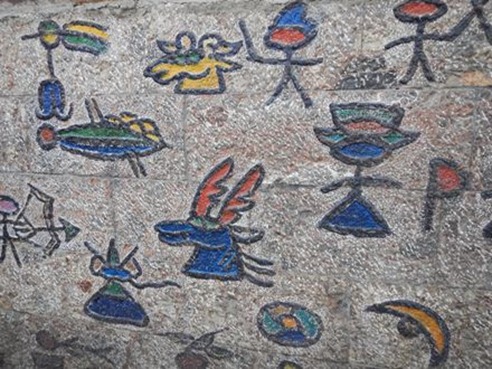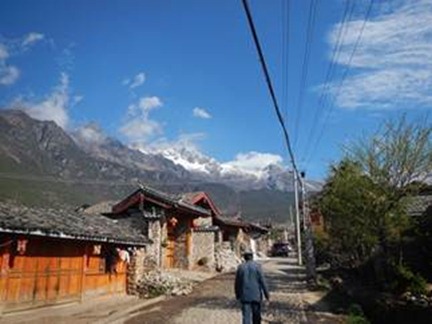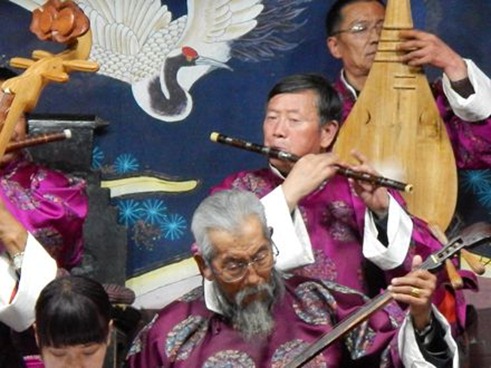China Tour - Lijiang and Baisha, Yunnan Province

|
Lijiang lies in the last area we were to visit in the North of Yunnan Province. Kathmandu and the tiny green triangle marking Everest can be seen over on the Chinese/Nepalese border at N28 E87 on the map and Lijiang is just about N27 E100.
Like Dali and the Stone Forest at Kunming, Liajiang is a UNESCO World Heritage site. It is a place where the main civilisations of East Asia intersected and integrated creating an original and diverse culture currently represented through the ethnic minorities of the Yi and the Naxi people. We arrived there to be met by Phyllis who was of the Yi people and who would be our guide for this last leg of our tour. The old town is extremely picturesque and happily our hotel overlooked it all.
Phyllis showed us around taking us to the main square and several others which had been ancient trading areas. In the past as well as agricultural produce, farming equipment and craft work there were specialist areas such as the square for trading horses and another for feed known as grass sellers' street. They are still very busy places with shophouses, street traders and hawkers plying their wares as well as restaurants and lovely tea houses. Horses can be hired to take visitors around the town which is appears very higgledy piggledy to an outsider who can spend hours walking and trying to find the way about. Traditional musical instruments can be bought here, particularly a local drum which looks very like the hand drums of some South American countries. The rhythms resound around the town; some guest drummers from Uganda caused quite a gathering in one town square.
There is water everywhere as it flows down from the mountains to form swift shallow rivers around the town. These were canalised many moons ago with lots of bridges linking the cobbled streets with their grey tiled roofs creating beautifully scenic views.
The clean fast flowing water means lots of wells around the town but these are quite unusual as the water flows through them rather than welling up from below. The unusual design is well known in the province.
The first section is for drinking, the second for washing and preparing vegetables and the last for washing clothes. The plinths dividing the sections are for sitting or kneeling on to perform the tasks. We didn't see anyone drinking or doing the laundry but we saw a few people cleaning their vegetables which are grown nearby.
The tea houses in the town are extremely attractive, mostly overlooking the waterways and with an abundance of shrubs and flowers.
Because of the climate here many of the plants are the same as those we grown in UK as well as the more tropical. A typical planting might include bamboo, gingko, acers, wisteria, azaleas and bougainvillea, peonies and a variety of bedding plants. The streets of Lijiang are also full of pink rambling roses.
Chris and Peter with Phyllis our guide.
Baisha is just north of Lijiang and our final day was spent at Yuhu, a Baisha Hill Village where hardy Naxi people live in these China Tibetan borderlands. These people were very isolated from the rest of China and still have cultural traditions emanating from ancient China, Tibet and Mongolia which have disappeared elsewhere. The Naxi are said to be unique in the Ethnographic Record. Amongst their special characteristics is the continuing use of a pictographic script and the religion associated with it which is the development of a philosophy that stresses respect for and conservation of nature. Over centuries the Naxis have produced thousands of religious books which are treasured in the hands of their religious specialists and are known as the Dongba Classics. These classics and the Naxi pictographic script were initially brought to world attention by Joseph Rock an American who lived in Yuhu village with the Naxi studying their culture, photographing and writing about the people whom he loved and stayed with for more than 20 years during the first half of the 20th century. Several Dongba religious scripts that were entrusted to Joseph Rock who wanted to take them to be examined in a US museum; unfortunately they were lost forever during a terrible storm at sea. However, Rock's memory is still precious to the Naxi and his house in Yuhu has been preserved as a museum to his time there. The Naxi territory only really opened up to the outside world in the 1980's and the people and their culture are now the subject of much research as they are a key to ancient North Asian civilisations and the archaic culture of China.
Fortunately for us we were able to see a mural of the pictographic script which only men boys are allowed to learn despite the matrilineal tendencies of their society.

This is the only pictographic script in the world still in use.
Yuhu Village, Baisha
Our last evening was back in Lijiang for a performance of ancient Donjing and Baishaxi music at the Dongba Palace Theatre. This snapshot shows just a few of the 28 musicians who entertained us five of whom were in their mid 80s.They are much revered and known locally as the fossils of the orchestra.
Another fossil was 84 year old Xuan Ke of Tibet-Naxi nationality and born in Lijiang. Speaking many languages, having taught in universities around the world he has a thirst for knowledge and deep interest in Ethnic viewpoints. He sees music and dance as central to civilisation and culture and works to research and preserve original instruments, ancient musical pieces, songs and dance. He has a strong following, especially in this part of China which he loves. This man looks only about 60 years old with the rigorous intellect for which the Naxi people are renowned. Unfortunately we don't have his photograph but we like this one of another octogenarian and leading member of the orchestra.
Well it's back to Shanghai for us. We have been in a fascinating and beautiful part of China, Yunnan Province is remarkable and we leave Lijiang exhausted but happy.
|














